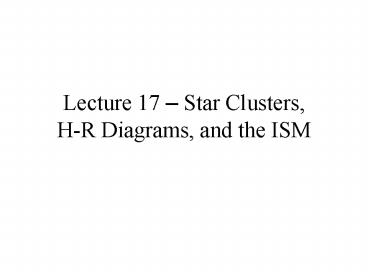Lecture 17 Star Clusters, HR Diagrams, and the ISM - PowerPoint PPT Presentation
1 / 30
Title:
Lecture 17 Star Clusters, HR Diagrams, and the ISM
Description:
Star clusters offer good test of stellar evolution theory because the stars in a ... Panorama Showing Interaction of Gas, Dust, and Stars ... – PowerPoint PPT presentation
Number of Views:36
Avg rating:3.0/5.0
Title: Lecture 17 Star Clusters, HR Diagrams, and the ISM
1
Lecture 17 Star Clusters, H-R Diagrams, and
the ISM
2
Lecture 17 Star Clusters, H-R Diagrams the
Interstellar Medium
- Star clusters offer good test of stellar
evolution theory because the stars in a given
cluster all have the same distance, initial
chemical composition, and age (each need to be
determined). The only variable is the mass of
individual stars. - Interstellar dust causes extinction and reddening
of optical light from background stars, as well
as reflection nebulae around embedded or nearby
stars. - Interstellar gas is observed in optical,
infrared, and radio radiation as emission
nebulae, with the emission arising from thermal
processes in ionized nebulae (H II regions) and
planetary nebulae. In supernova remnants,
emission in X-rays can arise from very hot
shocked gas (T gt K), or from the nonthermal
process of synchrotron radiation of relativistic
electrons gyrating wildly in magnetic fields.
3
Summary of Lives of Stars
4
Measuring Distance by Parallax Works for
Relatively Close-by Stars
5
Distances Based on Apparent and Absolute
Brightnesses Must Account for Interstellar
Extinction
Discovery of Interstellar Extinction by Robert
J. Trumpler (1886-1956)
6
Dark Cloud Seen AgainstRich Background of Stars
7
Dark Clouds Seen Against Bright Background of
Emission Nebula (H II Region)
8
Why Interstellar Medium is Interesting
- ISM is not empty it contains
- small solid particles dust grains,
- gas, atomic and molecular, as well as plasma,
- relativistic particles cosmic rays,
- magnetic fields.
- ISM is kept active by interactions with stars
- Luminous stars provide continuous source of
energy in form of starlight, especially UV light. - Dying stars provide source of processed matter as
well as input of kinetic energy. - ISM provides the cradles of star birth, supplying
the raw material for new generations of stars and
planets. - The last two processes provide the explanation
for the differences between Population I and
Population II stars.
9
Panorama Showing Interaction of Gas, Dust, and
Stars
10
Blue Sky Coupled with Reddening of Sun at Sunset
Sunrise
11
Observational Evidence for Interstellar Dust and
Gas
- Reflection nebula ? Dust surrounding star.
- Stationary absorption lines in spectra of binary
? Cool gas between us and stars.
12
Reflected Starlight Looks Bluer Than Illuminating
Stars
13
Halo of Light from Pleiades Classical
Reflection Nebula
14
Hot Young Stars Ionize the Material Around Them,
Producing H II Regions
Central star emits ultraviolet radiation, which H
II region degrades by fluorescence into visible
and infrared radiation.
15
H II Regions Show Characteristic Red Light of
Fluorescing H
16
A Star Cluster at Birth is Closely Associated
with Gas and Dust
17
Open Star Clusters Are Found in the Disk of the
Galaxy
18
Globular Star Clusters Are Foundin the Halo of
the Galaxy
19
H-R Diagram of Open Clusters
- Investigation by Trumpler of H-R diagram of open
star clusters. - Recognition that main-sequence turnoff represents
core-hydrogen exhaustion. - Nature of stellar nuclear reactions explained by
Bethe, Hoyle, Salpeter, Cameron, and their
collaborators. - Modern computation of stellar structure and
evolution by computers.
20
H-R Diagram of Pleiades Shows Both
Pre-Main-Sequence and Post-Main-Sequence Stars
Stars leaving the main sequence
Stars still contracting to the main sequence
21
Evolution of Stars of Different Masses Off the
Main Sequence
Evolutionary tracks of stars of different masses
with similar abundances of heavy elements as Sun
(Population I).
22
Turnoff Points of Different Open Clusters
23
H-R Diagram of Globular Cluster Implies Its Stars
Are Very Old (and Deficient in Heavy Elements)
24
A Globular Cluster Replete with White Dwarfs
Verifies Its Great Age
25
Supernova Remnants Produce Both Thermal and
Nonthermal Emission Nebulae
26
Nonthermal Continuum Emission Synchrotron
Emission
27
Different States of Gas in the ISM
28
Radio Observations of Interstellar Atomic
Hydrogen
Also possible with transitions between various
rotational states of molecules, but not H .
2
29
Molecular Clouds Are Where Stars Are Being Born
Today
30
Gas-Star Cycle in the Galaxy

